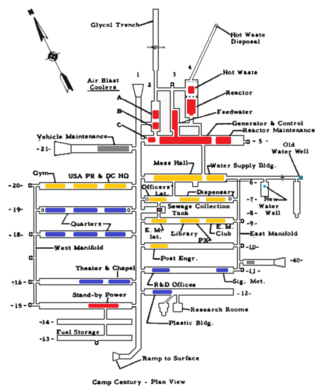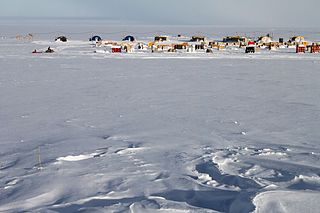
An oil platform is a large structure with facilities to extract and process petroleum and natural gas that lie in rock formations beneath the seabed. Many oil platforms will also have facilities to accommodate the workers, although it is also common to have a separate accommodation platform bridge linked to the production platform. Most commonly, oil platforms engage in activities on the continental shelf, though they can also be used in lakes, inshore waters, and inland seas. Depending on the circumstances, the platform may be fixed to the ocean floor, consist of an artificial island, or float. In some arrangements the main facility may have storage facilities for the processed oil. Remote subsea wells may also be connected to a platform by flow lines and by umbilical connections. These sub-sea facilities may include one or more subsea wells or manifold centres for multiple wells.

An ice core is a core sample that is typically removed from an ice sheet or a high mountain glacier. Since the ice forms from the incremental buildup of annual layers of snow, lower layers are older than upper ones, and an ice core contains ice formed over a range of years. Cores are drilled with hand augers or powered drills; they can reach depths of over two miles (3.2 km), and contain ice up to 800,000 years old.

The Greenland Ice Core Project (GRIP) was a research project organised through the European Science Foundation (ESF). The project ran from 1989 to 1995, with drilling seasons from 1990 to 1992. In 1988, the project was accepted as an ESF-associated program, and in the summer of 1989, the fieldwork was started in Greenland.

The Greenland Ice Sheet Project (GISP) was a decade-long project to drill ice cores in Greenland that involved scientists and funding agencies from Denmark, Switzerland and the United States. Besides the U.S. National Science Foundation (NSF), funding was provided by the Swiss National Science Foundation and the Danish Commission for Scientific Research in Greenland. The ice cores provide a proxy archive of temperature and atmospheric constituents that help to understand past climate variations.

The drilling site of the North Greenland Ice Core Project (NGRIP or NorthGRIP) is near the center of Greenland (75.1 N, 42.32 W, 2917 m, ice thickness 3085). Drilling began in 1999 and was completed at bedrock in 2003. The cores are cylinders of ice 11 centimeters in diameter that were brought to the surface in 3.5-meter lengths. The NGRIP site was chosen to extract a long and undisturbed record stretching into the last glacial, and it succeeded. The site was chosen for a flat basal topography to avoid the flow distortions that render the bottom of the GRIP and GISP cores unreliable. Unusually, there is melting at the bottom of the NGRIP core - believed to be due to a high geothermal heat flux locally. This has the advantage that the bottom layers are less compressed by thinning than they would otherwise be: NGRIP annual layers at 10.5 kyr age are 1.1 cm thick, twice the GRIP thicknesses at equal age.
The Older Dryas was a stadial (cold) period between the Bølling and Allerød interstadials, about 14,000 years Before Present, towards the end of the Pleistocene. Its date is not well defined, with estimates varying by 400 years, but its duration is agreed to have been around 200 years.

Dye 3 is an ice core site and previously part of the DYE section of the Distant Early Warning (DEW) line, located at in Greenland. As a DEW line base, it was disbanded in years 1990/1991.

Camp Century was an Arctic United States military scientific research base in Greenland. situated 240 km (150 mi) east of Pituffik Space Base. When built, Camp Century was publicized as a demonstration for affordable ice-cap military outposts and a base for scientific research.

The WAIS Divide is the ice flow divide on the West Antarctic Ice Sheet (WAIS) which is a linear boundary that separates the region where the ice flows to the Ross Sea, from the region where the ice flows to the Weddell Sea. It is similar to a continental hydrographic divide.

Summit Camp, also Summit Station, is a year-round staffed research station near the apex of the Greenland ice sheet. The station is located at 3,216 metres (10,551 ft) above sea level.

NEEM Camp was a small research facility on the northern Greenland Ice Sheet, used as a base for ice core drilling. It was located about 313 km east of the closest coast, Peabody Bay in northern Greenland, 275 km northwest of the historical ice sheet camp North Ice, and 484 km east-northeast of Siorapaluk, the closest settlement. There was one heavy-duty tent for accommodation of the researchers during summer. Access was by skiway .

Nerilie Abram is an Australian professor at the ANU Research School of Earth Sciences, Australian National University, Canberra, Australia. Her areas of expertise are in climate change and paleoclimatology, including the climate of Antarctica, the Indian Ocean Dipole, and impacts on the climate of Australia.
Dorthe Dahl-Jensen is a Danish palaeoclimatology professor and researcher at the Centre for Ice and Climate at the Niels Bohr Institute, University of Copenhagen in Denmark. Her primary field is the study of ice and climate, specifically the reconstruction of climate records from ice cores and borehole data; ice flow models to date ice cores; continuum mechanical properties of anisotropic ice; ice in the solar system; and the history and evolution of the Greenland Ice Sheet.
Single steel drilling caisson is a drill barge that was built for year-round oil exploration in shallow ice-covered waters in the Beaufort Sea. The unit, initially named SSDC and later shortened to SDC, was converted from an old oil tanker in the early 1980s. It has been used to drill a total of eight oil wells on both Canadian and U.S. continental shelves, the most recent in 2006.
KumikoGoto-Azuma is an Antarctic palaeoclimatologist and glaciologist and Director of the Ice Core Research Center at the National Institute of Polar Research, Japan.

Ice drilling allows scientists studying glaciers and ice sheets to gain access to what is beneath the ice, to take measurements along the interior of the ice, and to retrieve samples. Instruments can be placed in the drilled holes to record temperature, pressure, speed, direction of movement, and for other scientific research, such as neutrino detection.
Scientific ice drilling began in 1840, when Louis Agassiz attempted to drill through the Unteraargletscher in the Alps. Rotary drills were first used to drill in ice in the 1890s, and thermal drilling, with a heated drillhead, began to be used in the 1940s. Ice coring began in the 1950s, with the International Geophysical Year at the end of the decade bringing increased ice drilling activity. In 1966, the Greenland ice sheet was penetrated for the first time with a 1,388 m hole reaching bedrock, using a combination of thermal and electromechanical drilling. Major projects over the following decades brought cores from deep holes in the Greenland and Antarctic ice sheets.

Pavel Grigorievich Talalay, is a Russian professor of drilling engineering and director of the Institute for Polar Science and Engineering in Jilin University, Changchun, China. His research interests are focused on different features of drilling technology in ice and permafrost; dynamics of ice sheets; ice properties and environmental issues in Polar Regions.
Mary Remley Albert is an American earth scientist who is a Professor of Engineering at Dartmouth College. She studies snow physics and transport phenomena. She is executive director of the US Ice Drilling Program.













